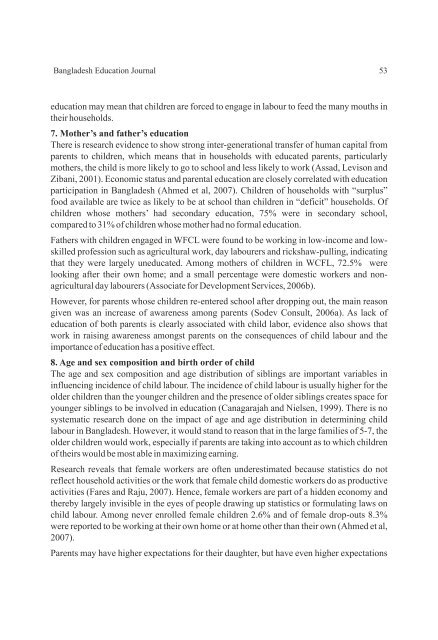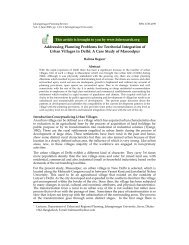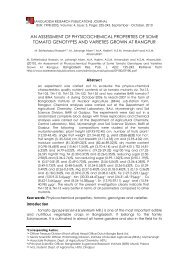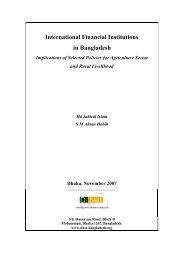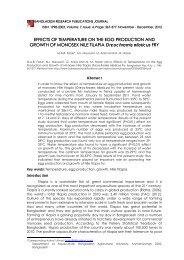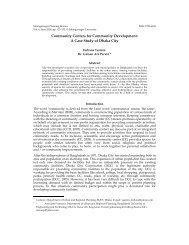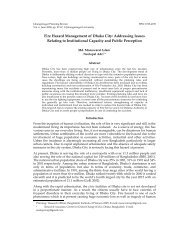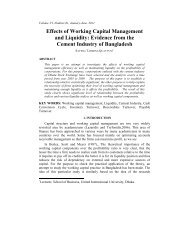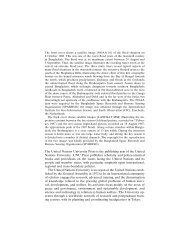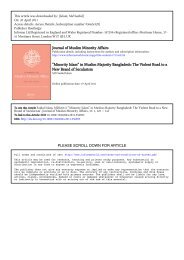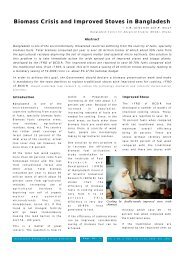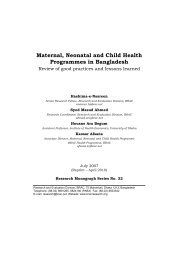Child Labour and Education in Bangladesh - Bangladesh Online ...
Child Labour and Education in Bangladesh - Bangladesh Online ...
Child Labour and Education in Bangladesh - Bangladesh Online ...
Create successful ePaper yourself
Turn your PDF publications into a flip-book with our unique Google optimized e-Paper software.
<strong>Bangladesh</strong> <strong>Education</strong> Journal 53education may mean that children are forced to engage <strong>in</strong> labour to feed the many mouths <strong>in</strong>their households.7. Mother’s <strong>and</strong> father’s educationThere is research evidence to show strong <strong>in</strong>ter-generational transfer of human capital fromparents to children, which means that <strong>in</strong> households with educated parents, particularlymothers, the child is more likely to go to school <strong>and</strong> less likely to work (Assad, Levison <strong>and</strong>Zibani, 2001). Economic status <strong>and</strong> parental education are closely correlated with educationparticipation <strong>in</strong> <strong>Bangladesh</strong> (Ahmed et al, 2007). <strong>Child</strong>ren of households with “surplus”food available are twice as likely to be at school than children <strong>in</strong> “deficit” households. Ofchildren whose mothers’ had secondary education, 75% were <strong>in</strong> secondary school,compared to 31% of children whose mother had no formal education.Fathers with children engaged <strong>in</strong> WFCL were found to be work<strong>in</strong>g <strong>in</strong> low-<strong>in</strong>come <strong>and</strong> lowskilledprofession such as agricultural work, day labourers <strong>and</strong> rickshaw-pull<strong>in</strong>g, <strong>in</strong>dicat<strong>in</strong>gthat they were largely uneducated. Among mothers of children <strong>in</strong> WCFL, 72.5% werelook<strong>in</strong>g after their own home; <strong>and</strong> a small percentage were domestic workers <strong>and</strong> nonagriculturalday labourers (Associate for Development Services, 2006b).However, for parents whose children re-entered school after dropp<strong>in</strong>g out, the ma<strong>in</strong> reasongiven was an <strong>in</strong>crease of awareness among parents (Sodev Consult, 2006a). As lack ofeducation of both parents is clearly associated with child labor, evidence also shows thatwork <strong>in</strong> rais<strong>in</strong>g awareness amongst parents on the consequences of child labour <strong>and</strong> theimportance of education has a positive effect.8. Age <strong>and</strong> sex composition <strong>and</strong> birth order of childThe age <strong>and</strong> sex composition <strong>and</strong> age distribution of sibl<strong>in</strong>gs are important variables <strong>in</strong><strong>in</strong>fluenc<strong>in</strong>g <strong>in</strong>cidence of child labour. The <strong>in</strong>cidence of child labour is usually higher for theolder children than the younger children <strong>and</strong> the presence of older sibl<strong>in</strong>gs creates space foryounger sibl<strong>in</strong>gs to be <strong>in</strong>volved <strong>in</strong> education (Canagarajah <strong>and</strong> Nielsen, 1999). There is nosystematic research done on the impact of age <strong>and</strong> age distribution <strong>in</strong> determ<strong>in</strong><strong>in</strong>g childlabour <strong>in</strong> <strong>Bangladesh</strong>. However, it would st<strong>and</strong> to reason that <strong>in</strong> the large families of 5-7, theolder children would work, especially if parents are tak<strong>in</strong>g <strong>in</strong>to account as to which childrenof theirs would be most able <strong>in</strong> maximiz<strong>in</strong>g earn<strong>in</strong>g.Research reveals that female workers are often underestimated because statistics do notreflect household activities or the work that female child domestic workers do as productiveactivities (Fares <strong>and</strong> Raju, 2007). Hence, female workers are part of a hidden economy <strong>and</strong>thereby largely <strong>in</strong>visible <strong>in</strong> the eyes of people draw<strong>in</strong>g up statistics or formulat<strong>in</strong>g laws onchild labour. Among never enrolled female children 2.6% <strong>and</strong> of female drop-outs 8.3%were reported to be work<strong>in</strong>g at their own home or at home other than their own (Ahmed et al,2007).Parents may have higher expectations for their daughter, but have even higher expectations


